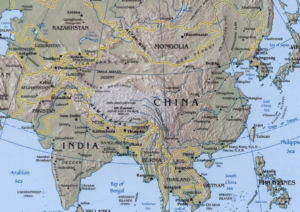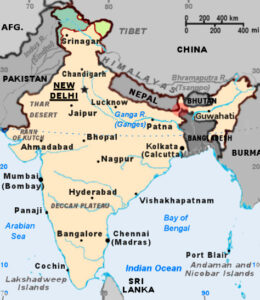- The history of armed conflict in Manipur, India’s northeastern state, is a complex narrative rooted in ethnic violence going back several decades.
- Several insurgent factions have emerged over the years, seeking greater autonomy in response to the perceived suppression of their cultural and linguistic identities by the Indian government.
- The persistence of the insurgency could undermine India’s national cohesion and create challenges to the national and regional order.
The growing insurgency in Manipur, India, has deep roots in long-standing ethnic and territorial conflicts. The situation in 2023 has been marked by an intensification of violence, with serious consequences for stability and security in the region.
Conflict violence, as well as gender-based violence against women, represents an alarming humanitarian and ethical concern. The insurgency in the state has been watched internationally and could have significant geopolitical implications for the northeastern region of India.

The history of armed conflict within India in the Manipur region caused by ethnic violence
The history of armed conflict is complex and goes back several decades. Ethnic violence in the region has deep roots in issues related to ethnic identity, territoriality, autonomy and political and economic marginalization.
Manipur is a state in northeast India known for its ethnic and cultural diversity. Before India’s independence in 1947, Manipur was an independent kingdom, but was annexed to Indian territory after Indian independence.
This integration process was not well received by all ethnic groups in Manipur, and it marked the beginning of tensions and discontent with the Indian central government.
After the annexation to India, various insurgent factions of the state emerged with demands for greater autonomy and, in some cases, complete independence.
These ethnic groups believed that their cultural, historical and linguistic identities were being suppressed by the Indian central government, and sought the preservation and protection of their rights and traditions.
Another point of tension was the territorial issue involving different ethnic communities in Manipur. Some insurgent factions pursued specific territorial claims, which often came into conflict with other communities, leading to violent disputes.
The Indian government’s response to the insurgency in Manipur was the militarization of the region. This has resulted in human rights violations, abuses of power and a spiral of violence between security forces and insurgent groups. The escalation of violence and the government’s heavy-handed response have heightened tensions and deepened hostility between the parties.
The political and economic marginalization of certain ethnic groups in Manipur also contributed to the conflict. Lack of adequate political representation, uneven development and socioeconomic disparities fueled discontent and a sense of injustice.
Furthermore, the insurgency in Manipur is not isolated, and insurgent groups have sought refuge and logistical support in neighboring countries such as Myanmar (Burma). The influence of cross-border activities can further exacerbate the conflict and complicate resolution efforts.
Over the decades, several attempts at resolution have been made by the Indian government, but a lasting solution to the conflict in Manipur has been elusive.

What are the rival parties to the conflict in Manipur?
These rival parties have different interests, identities and demands, which led to the conflict:
Meitei Community: The Meitei community is the dominant community in Manipur, representing the majority of the state’s population, which is around 3.5 million people. They are largely Hindu and have their base in the state capital, Imphal. Although the Meiteis are mostly concentrated in the plains, they also have a presence in the hills.
Naga and Kuki Tribes: The Naga and Kuki tribes are two significant ethnic groups in Manipur. They make up about 40% of the state’s population and, for the most part, follow the Christian religion. These tribes enjoy “Scheduled Tribe” status, which gives them ownership rights to land in the hills and forests of the region. Both groups have a significant presence in the Manipur hills.
In addition to the Meitei, Naga and Kuki communities, there is a diverse ethnic makeup in Manipur, with other tribal groups such as the Mizo present.
What caused the escalation of ethnic violence in Manipur in 2023
Violent clashes escalated in Churachandpur district in May 2023 between some of the predominantly Christian tribal groups in the region and the majority of the resident population, made up of Meiteis Hindus.
At the heart of this dispute was related to the Meiteis’ demand for access to forest lands, employment opportunities and places in educational institutions, which are traditionally reserved for the tribes under India’s affirmative action guarantees.
The Kuki community, which is predominant in Churachandpur, protests vehemently against the demands of the Meiteis to be recognized as a “Programmed Tribe”. For the Kuki, this concession would be seen as a violation of their own rights, as they consider themselves to be the marginalized part of the population, not the Meiteis.
The “Programmed Tribe” designation aims to implement affirmative action that guarantees representation and access to reserves and quotas in educational institutions and government jobs for historically marginalized communities. However, the dispute arises due to specific perceptions and concerns raised by tribal groups, including the Kuki.
The Kuki believe that the Meiteis already have a dominant political position in the state and that they exert significant influence over government decisions. They fear that granting the Meiteis “Programmed Tribe” status could affect their own employment and education opportunities, as well as allow the Meiteis to own land in the hills, a sensitive issue for the tribes, who already enjoy constitutional protections. in their tribal areas in northeast India.
The growing tension reflects tribal groups’ perception that the Meiteis may be reaping a disproportionate share of benefits and resources destined for marginalized communities.
Female bodies as a battleground in Manipur
In times of war, it is known and regrettable that women’s bodies often become part of the battlefield, with rape and sexual assault used as instruments of violence to punish them.
Sadly, a recent example of this violence occurred with Kuki women in Manipur. The images that reverberated from this assault, showing the women crying, expressing intense pain and begging their attackers for mercy, are deeply disturbing to watch.
The collective rape of the women took place after the village was burned, a scene of destruction and chaos. Furthermore, two men – one middle-aged and the other a teenager – were brutally beaten to death by the mob.
It is critical to recognize the gravity of gender-based violence, which is unacceptable and must be addressed with decisive action by authorities and society as a whole.
The heinous use of violence against women not only deepens social scars, but also has significant implications for regional security and human dignity.
Why the Armed Insurgency in the Indian State of Manipur Matters to the Geopolitics of the Region
The armed insurgency in the Indian state of Manipur is of extreme importance to the geopolitics of the region for several reasons:
Strategic Location: Manipur is located in the northeast region of India, sharing borders with Myanmar (Burma) and Bangladesh. Its strategic position makes the state an area of geopolitical interest, especially for India, which seeks to maintain security and stability in its borders.
Strategic Corridor: Northeast India, including Manipur, is a crucial region for connectivity between India and countries in Southeast Asia. It is seen as a strategic corridor for trade and diplomacy, making stability in Manipur vital to promoting India’s economic growth and political relations with its neighbours.
Border Transgressions: The Manipur region has been affected by cross-border insurgent activities. Armed groups in Manipur have sought refuge and logistical support in neighboring countries such as Myanmar, which creates challenges for security and regional cooperation.
Ethnic Diversity and Internal Conflict: Manipur is known for its ethnic and cultural diversity, but it has also been the scene of long-standing internal conflicts. The persistence of insurgency in the state could undermine India’s national cohesion and challenge its ability to maintain order and harmony in a region with a complex ethnic makeup.
External Interventions: The insurgency in Manipur may attract the attention and involvement of neighboring countries and external actors with geopolitical interests in the region. This can further complicate conflict resolution and create diplomatic tensions.
Impact on Regional Stability: The continuation of the insurgency in Manipur could have destabilizing effects on the entire region of North East India. Instability in one state can spill over to other neighboring states, exacerbating regional security challenges.
Growing International Concern: The persistence of the conflict in Manipur could attract the attention of the international community, leading to pressure for peaceful resolution and possible humanitarian assistance.
Given these factors, it is crucial that the Indian government and stakeholders in the region take a comprehensive and sensitive approach to address the roots of the insurgency in Manipur and seek a peaceful and lasting solution.
Stability in Manipur is essential for the peace and sustainable development of India’s northeastern region, as well as for diplomatic and economic relations with neighboring countries.





Be First to Comment